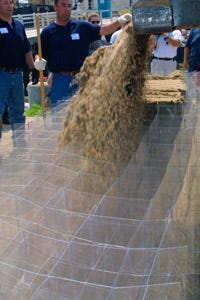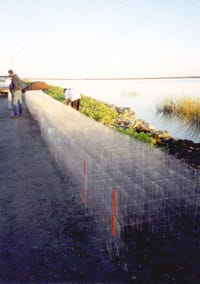Extruded Spectar sheet builds a better flood barrier
Sand and extruded copolyester sheet combine for a flood wall that can go up more quickly and withstand water better than the hand-filled sand bags they're aiming to replace.
August 27, 2010
Sand and extruded copolyester sheet combine for a flood wall that can go up more quickly and withstand water better than the hand-filled sand bags they're aiming to replace. Geocell Systems Inc.'s (San Francisco, CA) rapid-deployment flood wall (RDFW) uses interlocking sheets of a specially developed grade of copolyester from Eastman Chemical Co. (Kingsport, TN) to create an interlocking grid that can be filled rapidly with sand via loaders for flood barriers that offer speed in installation and strength in the face of natural disasters.
"In a flood fight, speed is of the essence," explains Gaylon White, director of design industry programs for Eastman. "You have to get whatever it is you're going to use out there and in place because things happen fast once the water arrives and starts to rise."
White and Eastman have worked with Geocell, and the RDFW's inventor, Al Arellanes, since work on the project started in earnest in 2000. Arellanes initially recognized the need for more efficient and effective means of flood containment when he worked as a Federal Emergency Management Agency (FEMA) employee and in the earthmoving industry. Prior to that in the early 1980s, Arellanes worked with the Army Corps of Engineers on developing a system for building roads over unstable soil, like sand.
Through that work, Arellanes and his team created what they called a sand confinement grid. Made from a high-strength plastic, the grid utilized the sand that's locked within it to build compression and create a passable road. Arellanes appreciated the potential the design had for flood containment, but had hit a conceptual wall in the technology's development as he worked towards a design that would allow a simple yet robust barrier.
Inspiration in a case of California wine
After finishing work on the final stage of the California aqueduct, Arellanes and his father were bidding out various earthwork projects, with the elder Arellanes skeptical about his son's plastic pursuits and search for a better sand-confinement structure. One
Geocell's rapid deployment flood wall being filled |
Geocell's rapid deployment flood wall. |
night relaxing with some wine, inspiration would come to Arellanes; not from the wine but rather his father and the box that held the bottles.
Removing bottles from their case to check the bottom for fermentation, Arellanes' father eventually emptied a box of wine, took out and collapsed the cardboard flats that separate the bottles, and tossed the bit of packaging to his son, saying, "This is what you ought to be using." In his hands, Arellanes had a structure that, when expanded, was a perfect containment grid, but could be collapsed down to a small, flat product. "Then, click, it just happened," Arellanes recalls. "We were able to change the configuration, alternate the cuts, and it evolved into the product we're using now."
Key to its functionality is the special copolyester grade, Spectar Clear. Arellanes had tried other materials, including high-density polyethylene and polyethylene terephthalate, but they didn't meet the application's stringent requirements. Working with sheet stock extruder, Spartech, Arellanes was put in touch with Eastman, which began work on a specialized grade.
Luis Pagan, business segment manager of the Retail and Architectural segments of Eastman's Specialty Plastics Business, collaborated with Geocell on a material that would meet the flood wall's needs. Weatherability would be key, as would chemical, water, and UV resistance. In addition, toughness was required since the sheets were die cut into their final form. Arellanes also wanted a material that could be reused, further increasing the cost effectiveness of the RDFW. Pagan says the Spectar Clear is a much tougher version of the typical copolyester, with the rigidity required for deployment, while being amorphous enough to be die cut. "If you have something that's too crystalline," Pagan says, "your dies aren't going to last too long."
The end result is a product that is rated to be reused three times, making it cheaper than its sand-bag competition. Eastman is also looking at a end-of-life chemical reclaim of the product, returning the polymer to its original building blocks and reconfiguring them into new, virgin materials.
Flood-tested and approved
In its present design, the RDFW can be deployed by two people, with the product unfolding into a 4-ft square that's 8 inches high. Those components can interlock to make varying widths and heights, with RDFW's stacked as high as 14 ft in some instances. Once they're deployed, earth-moving equipment can follow in behind and rapidly fill the grid structure with sand.
"As it is right now, our product is rated 100 times faster than sandbags," Arellanes says, adding that one base unit, the 4-ft-by-4-ft square that's 8 inches high, can be deployed in one second and once filled, is equivalent to a stack of 35 sandbags.
Since 2004, the RDFW has undergone laboratory and real-world field testing, with the Army Corps of Engineers using the RDFW without failure in presidentially declared flood-fighting emergencies in eastern Utah in 2007; Sacramento, CA, and Clarksville, MO, in 2008; and Jamestown and LaMoure, ND, in 2009.
In North Dakota, LaMoure deployed a half-mile of RDFW along a highway, while Jamestown had discrete deployments along 17 hot spots throughout the town. In the case of LaMoure, Arellanes says that 11 untrained firefighters built the half mile of barrier in "a matter of hours." Those towns were spared, while state capital Fargo, which didn't have RDFWs fared much worse.
Award-winning design
Following hard-fought acceptance for the product by the government, the RDFW is now earning accolades from the design community. At a 2007 design event in San Francisco, Eastman showed a Science Channel video clip of the product and were approached afterwards by John Caruso, an industrial designer out of Milwaukee who suggested they enter the RDFW in the Industrial Designers Society of America's (IDSA) IDEA (Industrial Design Excellence Award) contest.
This August in Portland, Geocell and Eastman did just that, and the RDFW was one of only 38 Gold Award winners out of 1900 entries. More impressively, it won the Designer's Choice award, beating out all the other products in the opinion of industrial designers themselves. "I think that speaks to how some of the best designers in the world view the design of this product," White says, "and Al deserves a lot of the credit because he's not a designer, he's an engineer."
At this point in time the Army Corps of Engineers is beginning to stockpile RDFWs at four strategic geographic locations in the U.S.: Sacramento, CA; Omaha, NE; Philadelphia, PA; and Rock Island, IL. Geocell is also starting to build an international distribution network to make the product available outside the U.S. In addition, the U.S. Marine Corps undertook testing of the product for blast mitigation at 29 Palms in California. They have been deployed in Iraq at Fallujah and Tikrit, as well as in Afghanistan. The blast wave from explosions is often the most lethal aspect, and the Spectar and sand have proven effective at absorbing it, bowing outwards but not giving way. "The most lethal part of the blast is the blast pressure," Arellanes says. "What we found is that the wall absorbs that blast pressure and reduces the effects from behind the wall."
About the Author(s)
You May Also Like




